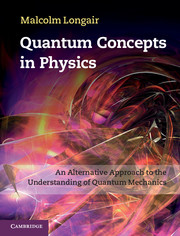Book contents
- Frontmatter
- Contents
- Preface
- Acknowledgements
- Part I The Discovery of Quanta
- Part II The Old Quantum Theory
- Part III The Discovery of Quantum Mechanics
- 10 The collapse of the old quantum theory and the seeds of its regeneration
- 11 The Heisenberg breakthrough
- 12 Matrix mechanics
- 13 Dirac's quantum mechanics
- 14 Schrödinger and wave mechanics
- 15 Reconcilingmatrix and wave mechanics
- 16 Spin and quantum statistics
- 17 The interpretation of quantum mechanics
- 18 The aftermath
- Epilogue
- Notes
- References
- Name index
- Subject index
15 - Reconcilingmatrix and wave mechanics
from Part III - The Discovery of Quantum Mechanics
Published online by Cambridge University Press: 05 February 2013
- Frontmatter
- Contents
- Preface
- Acknowledgements
- Part I The Discovery of Quanta
- Part II The Old Quantum Theory
- Part III The Discovery of Quantum Mechanics
- 10 The collapse of the old quantum theory and the seeds of its regeneration
- 11 The Heisenberg breakthrough
- 12 Matrix mechanics
- 13 Dirac's quantum mechanics
- 14 Schrödinger and wave mechanics
- 15 Reconcilingmatrix and wave mechanics
- 16 Spin and quantum statistics
- 17 The interpretation of quantum mechanics
- 18 The aftermath
- Epilogue
- Notes
- References
- Name index
- Subject index
Summary
The physics community was now faced with two theories of quantum phenomena which could scarcely have differed more radically from one another and yet both had achieved remarkable successes in explaining precisely the same physical phenomena – the spectral lines of the hydrogen atom, the zero point energy of quantum systems, the quantisation of the harmonic oscillator, the quantum rotator and the Stark effect. Furthermore, both theories could account for the experimental data, unlike the predictions of the old quantum theory. Perhaps these quite different approaches are not so surprising when it is appreciated that matrix and wave mechanics started from the diametrically opposite poles of the wave–particle duality.
At the heart of the Heisenberg approach was the fundamental role played by the non-commutative behaviour of the quantum variables and the quantisation of both the momentum and spatial variables. To accommodate these features, a new mathematical calculus had been invented from the realisation that matrices followed precisely the correct algebraic rules. The elaboration of this scheme led to the concept of the energy levels of a quantum system being associated with the diagonalisation of matrices using the eigenvalue procedure. As Jammer remarks, the theory
‘… defied any pictorial representation; it was an algebraic approach which, proceeding from the observed discreteness of spectral lines, emphasised the element of discontinuity; in spite of its renunciation of classical description in space and time it was ultimately a theory whose basic conception was the corpuscle.’
- Type
- Chapter
- Information
- Quantum Concepts in PhysicsAn Alternative Approach to the Understanding of Quantum Mechanics, pp. 292 - 311Publisher: Cambridge University PressPrint publication year: 2013



